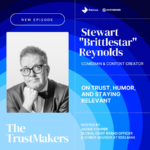By Steve Ford, Senior Vice President of Advertising & Distribution, ESL FACEIT Group
While the old adage of “go where your customers are” has never been more relevant, the rules of engagement are changing. With 90% of Gen Z and 94% of Gen Alpha identifying as gamers, marketers have to rethink their playbook. There are new virtual worlds to tap into, live experiences to show up at, and more influencers than ever to choose from.
For years, gaming was considered a subculture – today, it’s defining culture. So why is only 5% of global media investment allocated toward gaming? Lack of clarity around return on investment and misunderstanding of the industry have kept some brands from diving in with both feet.
Here is a look at how savvy marketers can effectively leverage user-generated content, live experiences, and creators to build brand affinity with the next generation of gamers.
Rules of Engagement: How To Make the Most of Your UGC Play
According to data from GEEIQ, over 1,065 brands have launched user-generated content activations, with more than half of them making their debut since the start of 2024. In fact, the data shows Gen Z spends more time on Roblox and Fortnite than on YouTube and TikTok combined.
That’s why companies like the NFL, Samsung, Versace, and more are building their own bespoke in-game activations or attaching themselves to popular existing content.
The NFL Zone is one example of how multi-faceted these activations can be, with league partners including Visa, content creators, and all 32 teams getting in on the action. With custom islands for each NFL franchise, mini-games, and content across social platforms, the NFL and Visa rewrote their engagement playbook and found a way to connect with the next generation of football fans through gaming.
Similarly, Versace didn’t just put its Mercury sneakers in a game; it integrated them into a popular Fortnite Murder Mystery map, creating an event that felt native to the platform and resonated with a new luxury audience.
While expectations and investment in these experiences are high, so too is the loyalty players display to brands that commit to adding value. Gen Z and Gen Alpha are 55% more likely to purchase a product they see in-game. This is in large part due to the perception that the brand is creating experiences alongside the consumer rather than buying their attention.
In-Person Connections: How to Leverage Esports to Build Brand Affinity
Esports is no longer a niche hobby; it’s a global phenomenon with real economic power. At ESL FACEIT Group (EFG), we’re seeing spending by attendees at our esports and gaming festivals increase 2X year-over-year. The rise in at-venue revenue is coupled with a slew of sold-out arenas, from the 41,000 fans at Intel Extreme Masters Cologne to hosting 60,000 at DreamHack Dallas. Both events contributed to nearly $220 million in economic impact across EFG events in 2024.
A recent survey by 3Gem also revealed that 90% of UK teens are more likely to attend a gaming festival than a concert – and 88% say gaming creators and esports pros are just as important, if not more so, than top music artists.
But it’s worth noting this community has a sharp radar for brands that are just passing through. While a single successful campaign is a great start, the ultimate ROI in gaming is trust, which is only built through consistently showing up and adding value.
Our partners at Intel and DHL know this all too well. The brands have embedded themselves in esports: Intel for nearly 25 years through its Intel Extreme Masters competition circuit, and DHL for the past seven through a variety of activations including event giveaways, appearances on Fortnite maps, the creation of its bespoke esports mascot Cargo, and more. DHL also launched “The Dispatch,” a comedy mini-series on YouTube that drew more than 21,000 click-throughs to the company’s recruitment page from members of the EFG community looking to become part of the DHL family. Both brands have been able to consistently tap into a global audience of 640 million esports fans and build loyalty by being part of the experience for both fans and competitors.
Chipotle has become a beloved brand in the fighting game community, thanks to a multi-faceted approach including live activations. The chain earned cheers during its advertisements at EVO because it’s consistently shown up for fighting game fans over recent years, from hosting competitions to offering in-game currency and more.
From Sony to Mastercard, Lamborghini, and more, brands have discovered that being where gamers are – literally – is the fastest path to not just brand awareness, but lifelong loyalty.
Familiar Faces: Build Alongside Creators for a Competitive Edge
Nearly half of the content Gen Z consumes comes from creators, and they follow twice as many internet influencers as athletes. Leveraging these internet stars can help brands connect with an audience that trusts what content creators endorse.
GoPro did just that by partnering with Dude Perfect to integrate into their Dodge Ball Royale game on Fortnite. With 60 million YouTube subscribers, Dude Perfect’s title came with a built-in community of potential players and lowered the risk of investing in a full UGC experience.
Meanwhile, brands like Red Bull are signing creators alongside the competitors the company is known to sponsor. Talent including Ludwig “Ludwig” Ahgren, Ali “SypherPK” Hassan, and others have signed on as Red Bull Players to give their content wings and further brand awareness in a highly competitive category.
Creator partnerships bridge the gap between innovation and security. By leveraging the familiarity of influencer marketing – which is already a staple for most brands – marketers can present bold, creative initiatives as a low-risk, high-reward opportunity that leadership can confidently green light.
It’s Never Too Late to Engage
Competition for consumers’ attention has never been more heated, but there are more ways than ever to reach potential fans. While many companies have jumped in and embraced gaming culture, there’s still plenty of room for brands who can creatively, and consistently, add value for this audience of 3.6 billion people.
The brands that will win the loyalty of the next generation will be the ones that show up authentically, contribute meaningfully, and become a part of the community.











